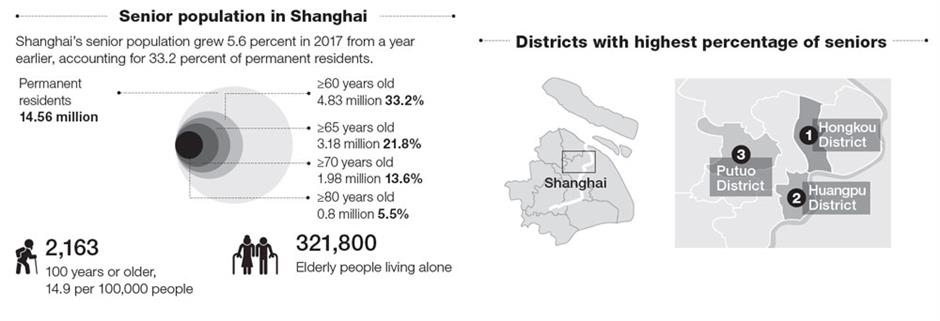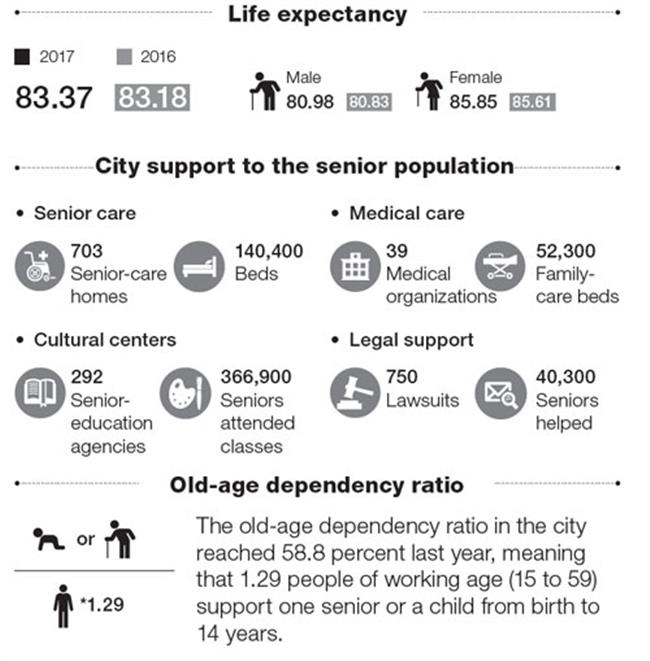
SHANGHAI’S senior population grew 5.6 percent last year from 2016, accounting for 33.2 percent of permanent residents.
The number of people aged 60 or above totaled 4.84 million at the end of 2017, according to the Shanghai Civil Affairs Bureau.
A baby boom in the mid-to-late 1950s means that the age group between 60 and 69 years old has now increased sharply — accounting for nearly 60 percent of senior population in the city, said Zhang Linjun, deputy director of the Shanghai Research Center on Aging affiliated to the bureau.
Hongkou, Huangpu and Putuo districts have the highest percentage of seniors. In 2017, 37.9 percent of permanent residents in Hongkou comprised people aged 60 or above, according to the bureau.
There were 805,800 people aged 80 or above last year, up 1.2 percent from 2016. The percentage of this age group among senior population, who have Shanghai household registration, or hukou, was 16.7 percent, down 0.7 percentage points from a year earlier. It was the first decrease in recent years, the bureau said.
The increase of seniors in this age group slowed and this trend is stable and should stay so for several years, said Zhang.
There were 2,163 centenarians at the end of last year, up 10.4 percent from 2016. There were 14.9 centenarians per 100,000 people at the end of 2017, compared with 13.5 in 2016.
 Shanghai Civil Affairs Bureau
Shanghai Civil Affairs BureauOf them, 1,614, or 74.6 percent, were women. Huangpu, Xuhui and Jing’an districts boasted the largest number of centenarians per 100,000 people, with 24.4, 22.7 and 20.1 respectively.
“It is very remarkable because a city can be called a ‘city of longevity’ when it has seven centenarians for every 100,000 people, and natural environment, medical care, social environment and other factors all affect the number of centenarian group,” Zhang said.
The average life expectancy of local residents reached 83.37 years last year, compared with 83.18 in 2016. It was 80.98 for men and 85.85 for women.
The top three killers for seniors were circulation system diseases, cancer and respiratory system diseases, according to the center.
The old-age dependency ratio in the city reached 58.8 percent last year, a record high and an increase of 4.7 percent from 2016, and the total dependency ratio was 77.1 percent, meaning 1.29 people of working age (15 to 59) support one senior or a child from birth to 14 years.
“The figure is the result of continuously increased aging population, and more senior care support is needed,” said Zhang.
The city had 321,800 elderly people living alone, and 33,000 had no spouse and child.
At the end of last year, Shanghai had 703 registered senior-care homes, with 140,400 beds — up 5.7 percent from 2016. Among them, 283 had incorporated medical treatment agencies.
In addition, there were 127 community-based senior centers with 3,430 beds and 560 day-care centers for the elderly. There were 292 senior education agencies, and 366,900 seniors attended classes last year.
